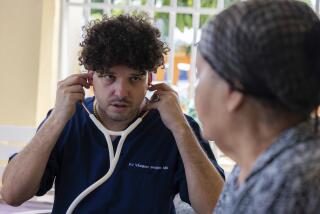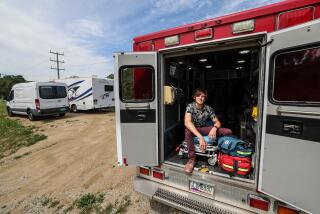$70,000 Van Set Up Like Doctor’s Office : Mobile Medics Make Calls on Homeless
ST. PETERSBURG, Fla. — Dr. Geoffrey Greene makes house calls, but only to people who don’t have homes.
Greene heads a mobile medical team that makes the rounds of Pinellas County shelters and soup kitchens to bring medicine--and hope--to those down on their health as well as their luck.
They work out of a $70,000 van set up like a doctor’s office.
“I was destitute. I got immediate help here and I’m very grateful,” said Otis Simone, 53, an out-of-work barber who suffers from bleeding ulcers and glaucoma.
Soup Kitchen
“No one else cared,” said Jim Daniels as he accompanied his fiancee, Elizabeth Craps, to the blue-and-white mini-clinic parked in front of St. Vincent de Paul’s soup kitchen. She was treated for anemia and seizures.
Greene, registered nurse Faith Bennett, social worker Phyllis Kleckley and secretary-driver Ann Campbell make up the team. Their workshop includes an exam table, scale, refrigerator for medicines, cabinet for supplies, telephone, bathroom and a tiny desk with a folder of files.
Medical care is free to the homeless in what county officials say is the only such mobile outreach operation of its kind in the Southeast.
“The concept is to go where the people are,” Greene said. “A lot of these people would have no medical treatment at all if not for a program like this.”
15 Patients a Day
They see an estimated 15 patients daily, many with problems related to alcohol and cocaine abuse. Others come with cuts from fights or muggings, feet or skin problems, lice, viruses, sometimes tumors. In children, the team finds everything from colds to chickenpox.
The program began last June and is operated by the county’s Department of Social Services under an annual budget of $265,000, said Supervisor Jim Dates.
“The only other program I know of that’s like it is in New York City,” Dates said. “There aren’t a lot of us.”
The county has two clinics that help the indigent. “But we felt very strongly that because the homeless people weren’t coming to them, we had to go out to them,” Dates said.
Greene was at the University of South Florida in 1986 doing his residency in internal medicine when he grew disillusioned.
Emphasis Misplaced
“I felt the emphasis was misplaced,” he said. “We need specialties. But a lot of medical problems we see are treatable and preventable long before they get to the intensive care stage.”
When he heard about the program, he applied.
The Mobile Medical Team also tries to plug in patients to other assistance programs--financial, vocational or established medical clinics if the ailment is long-term, such as diabetes.
Greene had expected to treat mostly middle-aged alcoholics. But he also found people with drug and mental problems, women with dependent children on the run from abusive husbands, families who could not make ends meet on unskilled minimum wage jobs and those who just chose to drop out and live on the edge.
“Like everyone, I had misconceptions about the homeless,” the doctor said. “You just don’t realize how bad it is until you start working with it.”
More Families
Dates, who has been involved in social work for nine years, said families account for the biggest increase in street people.
“In 1981-82 you almost didn’t see homeless families,” he said. “Now, all of a sudden, family shelters are bursting at the seams. And I don’t see any program coming along that’s going to get these people out of the situation they are in.”
Tanya Freeman, a 40-year-old grandmother, suffers from hearing impairment, heart disease, epilepsy and shortness of breath. She first met Greene at a shelter in July after she moved to Florida from the Bronx in New York City.
“I was raped and beaten and they helped me,” she says. “I had no place to go. Now, I’m in school studying electronics. I volunteer at the soup kitchen. And I’m getting a healthy body back.”
“They let me feel comfortable. Ever since I met them my life is going up, up, up, and I refuse to let it go back.”
More to Read
Sign up for Essential California
The most important California stories and recommendations in your inbox every morning.
You may occasionally receive promotional content from the Los Angeles Times.






